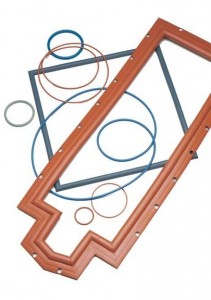This article was originally posted in the Parker Sealing & Shielding Blog and written by Michael Sobeski, Product Engineer, Parker O-Ring Division. For more information on additional products visit the Parker O-Ring Division Website.

This particular blog will provide an overview of the most important aspects of a good environmental seal, including the importance of good seal design, the certifications that provide confidence in the seal’s capability, and the available seal profiles useful for many different application constraints.
Seal Design
Keeping the environment outside your enclosure starts with proper seal design. Squeeze is the most important factor of this design. When you squeeze solid rubber material, the internal cross-linking of the elastomer resists deformation and pushes the rubber against the assembly allowing conformance to the surface. When good squeeze is achieved, the rubber provides an environmental barrier and the resiliency of solid rubber ensures the seal will last. The second most important factor of proper seal design is material selection. Many enclosures utilize cellular or foam rubber to achieve a cheap seal. While this may be an inexpensive option in the short term, cell and foam rubber do not have the same long term resistance that you find in solid rubber parts, which can cause leak paths to develop over time. Solid rubber, on the other hand, can provide a long term solution ensuring good reliability of your enclosure.
Industry Certifications
Your environmental enclosure may reside outdoors in a hot, arid desert or a wet, muddy swamp. Or, the enclosure could be placed indoors in an environment housing flammable chemicals or requiring a high degree of cleanliness. In order to ensure your enclosure works as intended, it is best to choose material that is suitable for a wide range of conditions. Industry certifications help provide assurance that your design keeps the environment out and provides a long lasting solution.
ASTM G21-96 helps measure a polymer’s resistance to fungal growth in this type of environment and UL 94 helps determine a material’s resistance to fire exposure. UL also has approvals for larger electronic boxes under the UL50E certification. Using select Parker materials, which are certified to UL50E, can help bypass additional testing that may be needed on other material in the marketplace. Parker also has experience with end-use certifications like IP65 and IP67.
By working with Parker Application Engineers during the design process, you can be assured that the chosen seal will help your enclosure meet the necessary certifications your customers require.
Seal Profiles
Seal configuration can often be the most challenging aspect of the design process. Real estate for cutting or molding a groove can be limited, part tolerances can be large, or available compressive force can be low. Fortunately, Parker has developed solutions for each of these cases. If available room is low or geometry is constrained, Parker can cut and splice seal material to the dimensions you require. In the event that enclosure tolerances are large or available compressive force is low, Parker engineers can design a custom hollow seal to help absorb large tolerances while providing very low compressive force compared to solid cord.
The continuous, solid nature of the rubber material allows hollow sections to be added to the seal with lower compressive force without compromising material integrity over the life of the product. The Parfab design guide shown below contains a sampling of the custom options we can provide.
For those not familiar with seal design, developing the proper seal for use in an enclosure can often seem like a daunting task. Parker Application Engineers and the Gallagher Engineering Department can assist with the design process to help ensure all of your requirements are met.
